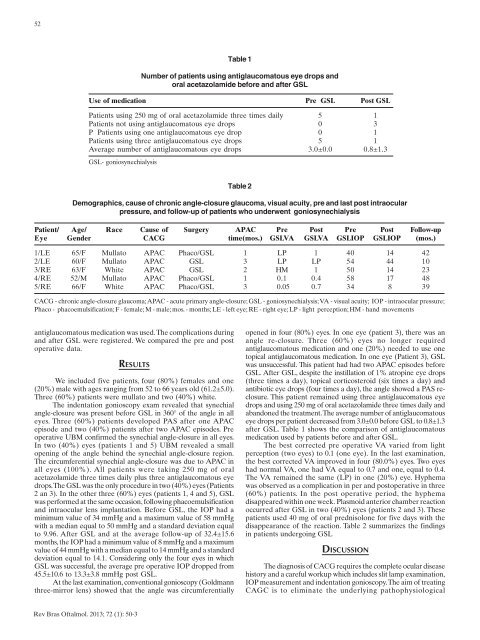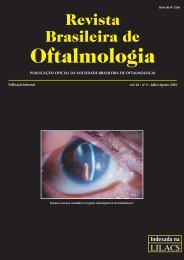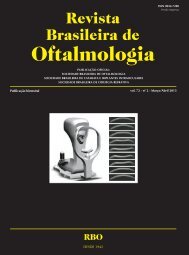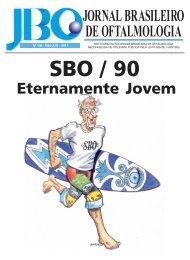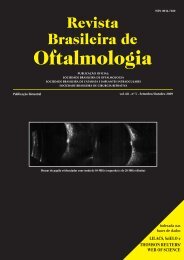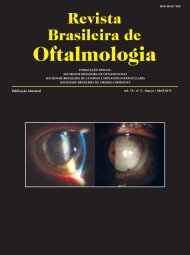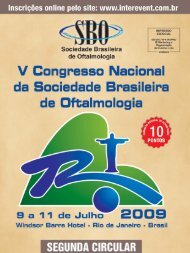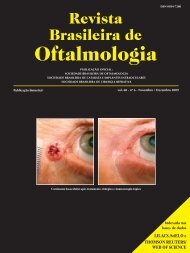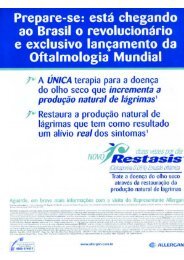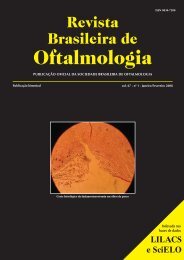to download PDF in portuguese - Sociedade Brasileira de ...
to download PDF in portuguese - Sociedade Brasileira de ...
to download PDF in portuguese - Sociedade Brasileira de ...
You also want an ePaper? Increase the reach of your titles
YUMPU automatically turns print PDFs into web optimized ePapers that Google loves.
52<br />
Use of medication Pre GSL Post GSL<br />
Patients us<strong>in</strong>g 250 mg of oral acetazolami<strong>de</strong> three times daily 5 1<br />
Patients not us<strong>in</strong>g antiglaucoma<strong>to</strong>us eye drops 0 3<br />
P Patients us<strong>in</strong>g one antiglaucoma<strong>to</strong>us eye drop 0 1<br />
Patients us<strong>in</strong>g three antiglaucoma<strong>to</strong>us eye drops 5 1<br />
Average number of antiglaucoma<strong>to</strong>us eye drops 3.0±0.0 0.8±1.3<br />
GSL- goniosynechialysis<br />
Table 1<br />
Number of patients us<strong>in</strong>g antiglaucoma<strong>to</strong>us eye drops and<br />
oral acetazolami<strong>de</strong> before and after GSL<br />
Table 2<br />
Demographics, cause of chronic angle-closure glaucoma, visual acuity, pre and last post <strong>in</strong>traocular<br />
pressure, and follow-up of patients who un<strong>de</strong>rwent goniosynechialysis<br />
Patient/ Age/ Race Cause of Surgery APAC Pre Post Pre Post Follow-up<br />
Eye Gen<strong>de</strong>r CACG time(mos.) GSLVA GSLVA GSLIOP GSLIOP (mos.)<br />
1/LE 65/F Mulla<strong>to</strong> APAC Phaco/GSL 1 LP 1 40 14 42<br />
2/LE 60/F Mulla<strong>to</strong> APAC GSL 3 LP LP 54 44 10<br />
3/RE 63/F White APAC GSL 2 HM 1 50 14 23<br />
4/RE 52/M Mulla<strong>to</strong> APAC Phaco/GSL 1 0.1 0.4 58 17 48<br />
5/RE 66/F White APAC Phaco/GSL 3 0.05 0.7 34 8 39<br />
CACG - chronic angle-closure glaucoma; APAC - acute primary angle-closure; GSL - goniosynechialysis; VA - visual acuity; IOP - <strong>in</strong>traocular pressure;<br />
Phaco - phacoemulsification; F - female; M - male; mos. - months; LE - left eye; RE - right eye; LP - light perception; HM - hand movements<br />
antiglaucoma<strong>to</strong>us medication was used. The complications dur<strong>in</strong>g<br />
and after GSL were registered. We compared the pre and post<br />
operative data.<br />
RESULTS<br />
We <strong>in</strong>clu<strong>de</strong>d five patients, four (80%) females and one<br />
(20%) male with ages rang<strong>in</strong>g from 52 <strong>to</strong> 66 years old (61.2±5.0).<br />
Three (60%) patients were mulla<strong>to</strong> and two (40%) white.<br />
The <strong>in</strong><strong>de</strong>ntation gonioscopy exam revealed that synechial<br />
angle-closure was present before GSL <strong>in</strong> 360° of the angle <strong>in</strong> all<br />
eyes. Three (60%) patients <strong>de</strong>veloped PAS after one APAC<br />
episo<strong>de</strong> and two (40%) patients after two APAC episo<strong>de</strong>s. Pre<br />
operative UBM confirmed the synechial angle-closure <strong>in</strong> all eyes.<br />
In two (40%) eyes (patients 1 and 5) UBM revealed a small<br />
open<strong>in</strong>g of the angle beh<strong>in</strong>d the synechial angle-closure region.<br />
The circumferential synechial angle-closure was due <strong>to</strong> APAC <strong>in</strong><br />
all eyes (100%). All patients were tak<strong>in</strong>g 250 mg of oral<br />
acetazolami<strong>de</strong> three times daily plus three antiglaucoma<strong>to</strong>us eye<br />
drops. The GSL was the only procedure <strong>in</strong> two (40%) eyes (Patients<br />
2 an 3). In the other three (60%) eyes (patients 1, 4 and 5), GSL<br />
was performed at the same occasion, follow<strong>in</strong>g phacoemulsification<br />
and <strong>in</strong>traocular lens implantation. Before GSL, the IOP had a<br />
m<strong>in</strong>imum value of 34 mmHg and a maximum value of 58 mmHg<br />
with a median equal <strong>to</strong> 50 mmHg and a standard <strong>de</strong>viation equal<br />
<strong>to</strong> 9.96. After GSL and at the average follow-up of 32.4±15.6<br />
months, the IOP had a m<strong>in</strong>imum value of 8 mmHg and a maximum<br />
value of 44 mmHg with a median equal <strong>to</strong> 14 mmHg and a standard<br />
<strong>de</strong>viation equal <strong>to</strong> 14.1. Consi<strong>de</strong>r<strong>in</strong>g only the four eyes <strong>in</strong> which<br />
GSL was successful, the average pre operative IOP dropped from<br />
45.5±10.6 <strong>to</strong> 13.3±3.8 mmHg post GSL.<br />
At the last exam<strong>in</strong>ation, conventional gonioscopy (Goldmann<br />
three-mirror lens) showed that the angle was circumferentially<br />
opened <strong>in</strong> four (80%) eyes. In one eye (patient 3), there was an<br />
angle re-closure. Three (60%) eyes no longer required<br />
antiglaucoma<strong>to</strong>us medication and one (20%) nee<strong>de</strong>d <strong>to</strong> use one<br />
<strong>to</strong>pical antiglaucoma<strong>to</strong>us medication. In one eye (Patient 3), GSL<br />
was unsuccessful. This patient had had two APAC episo<strong>de</strong>s before<br />
GSL. After GSL, <strong>de</strong>spite the <strong>in</strong>stillation of 1% atrop<strong>in</strong>e eye drops<br />
(three times a day), <strong>to</strong>pical corticosteroid (six times a day) and<br />
antibiotic eye drops (four times a day), the angle showed a PAS reclosure.<br />
This patient rema<strong>in</strong>ed us<strong>in</strong>g three antiglaucoma<strong>to</strong>us eye<br />
drops and us<strong>in</strong>g 250 mg of oral acetazolami<strong>de</strong> three times daily and<br />
abandoned the treatment. The average number of antiglaucoma<strong>to</strong>us<br />
eye drops per patient <strong>de</strong>creased from 3.0±0.0 before GSL <strong>to</strong> 0.8±1.3<br />
after GSL. Table 1 shows the comparison of antiglaucoma<strong>to</strong>us<br />
medication used by patients before and after GSL.<br />
The best corrected pre operative VA varied from light<br />
perception (two eyes) <strong>to</strong> 0.1 (one eye). In the last exam<strong>in</strong>ation,<br />
the best corrected VA improved <strong>in</strong> four (80.0%) eyes. Two eyes<br />
had normal VA, one had VA equal <strong>to</strong> 0.7 and one, equal <strong>to</strong> 0.4.<br />
The VA rema<strong>in</strong>ed the same (LP) <strong>in</strong> one (20%) eye. Hyphema<br />
was observed as a complication <strong>in</strong> per and pos<strong>to</strong>perative <strong>in</strong> three<br />
(60%) patients. In the post operative period, the hyphema<br />
disappeared with<strong>in</strong> one week. Plasmoid anterior chamber reaction<br />
occurred after GSL <strong>in</strong> two (40%) eyes (patients 2 and 3). These<br />
patients used 40 mg of oral prednisolone for five days with the<br />
disappearance of the reaction. Table 2 summarizes the f<strong>in</strong>d<strong>in</strong>gs<br />
<strong>in</strong> patients un<strong>de</strong>rgo<strong>in</strong>g GSL<br />
DISCUSSION<br />
The diagnosis of CACG requires the complete ocular disease<br />
his<strong>to</strong>ry and a careful workup which <strong>in</strong>clu<strong>de</strong>s slit lamp exam<strong>in</strong>ation,<br />
IOP measurement and <strong>in</strong><strong>de</strong>ntation gonioscopy. The aim of treat<strong>in</strong>g<br />
CAGC is <strong>to</strong> elim<strong>in</strong>ate the un<strong>de</strong>rly<strong>in</strong>g pathophysiological<br />
Rev Bras Oftalmol. 2013; 72 (1): 50-3


